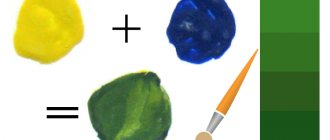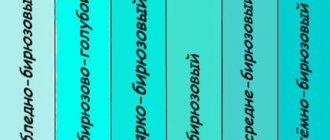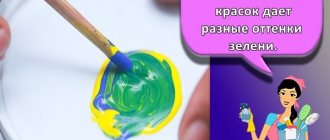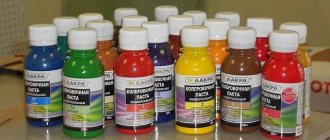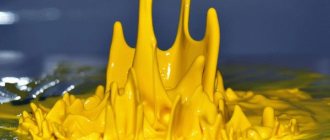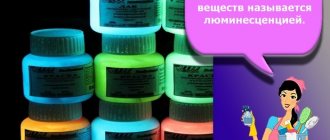There are thermochromic compounds that change color when exposed to heat (color indicators of temperature). In technology, they are usually used instead of thermometers to measure temperature where it is difficult to measure it using conventional methods. The recipes for such paints are quite complex. But if you want to experiment with unusual thermometer paints, I offer you several accessible recipes.
The most common compound is zinc white (zinc oxide) ZnO. At normal temperatures they are white. If zinc oxide is heated above 180°C, it will acquire a yellowish tint. If you then cool it to below 180°C, it will gradually turn white again. However, zinc oxide changes its color gradually, and not in a strictly defined temperature range.
Much more interesting in this regard is mercury iodide HgI2. At normal temperatures it is bright red, and at a temperature of 126-127°C it becomes lemon yellow. As the temperature decreases, this compound acquires its previous color.
How to obtain mercury iodide?
Mercury and all compounds of this metal are harmful to health. It is not recommended to experiment with mercury at home. It is better to do this in a chemistry circle under the guidance of a teacher.
The first method: you need to grind metallic mercury with double the amount of crystalline iodine. Second method: dissolve a few drops of mercury in 10-15 ml of nitric acid. As a result of the reaction, which is accompanied by the release of brown nitric oxide, mercury nitrate (mercuric nitrate) Hg(NO3)2 is formed. Dissolve 3-5 g of potassium iodide in a separate test tube, and then pour this solution into the prepared solution of mercury nitrate. As a result of the reaction, bright red mercury iodide HgI2 will precipitate.
The precipitate must be filtered and washed on a filter. Remove from paper and air dry.
Hydrochromic enamel for car
Hydrochromic paint allows you to change the color of your car when it gets wet. Special microgranules, sensitive to moisture, give this enamel a regular white coating when dry. However, when exposed to water, the white paint becomes transparent and the color applied on the bottom layer shows through.
Of course, the hydrochromic version provides much less options than the heat-sensitive one. However, this type of painting is also successfully used by some car enthusiasts. In fact, there is no need to completely paint the body using a hydrochromic product. It is enough to apply it to certain areas, hiding decorative elements that will appear when the car gets wet. Such substances are non-toxic and do not harm human health or the environment.
Mercury iodide changes color
Apply a small amount of mercury iodide in a thin layer to a glass plate or a sheet of paper placed on a steel plate (tin). Tin is needed for uniform heating. Please note that when heated above 250 °C, mercury iodide decomposes.
As the powder gradually heats up, it will change its color from red to lemon yellow when the temperature is reached. As the plate cools, the mercury iodide will turn red again.
Thermal paint that reacts to temperatures of 60-65 ° C
Dissolve 2.5 g of potassium iodide KI in 20 ml of distilled water. When potassium iodide is completely dissolved, add 8 g of mercury iodide Hgl2 to the solution. Label it as solution No. 1. Then, in another test tube, dissolve 3 g of copper sulfate CuSO4 in 20 ml of distilled water. This will be solution No. 2. Pour solution No. 2 into the flask and add solution No. 1 to it in small portions, gradually stirring. A red precipitate will form. It is a rather complex compound Cu2(HgI4) containing copper, iodine and mercury.
Let the mixture sit for about 30 minutes, after which carefully drain the clear liquid, place the sediment on a paper filter and rinse thoroughly at least ten times with distilled water.
The dry sediment, thoroughly ground into powder, can now be mixed with drying oil to create a thermal paint for coating metal, ceramic and wooden surfaces. But you can mix the powder with liquid flour paste - with such paints you can write or draw on paper and cardboard. Once dry, the drawing becomes red. If you bring it close to an incandescent lamp, central heating radiator or other heat source, it will turn brown, and after cooling it will turn red again.
Using thermal paints on drying oil, you can paint, for example, narrow stripes on a central heating radiator. Their color will indicate whether the battery temperature is above 65°C or below 60°C.
Preparing the car for painting
Preparing a car for self-painting with auto enamel that changes the color is no different from work before regular painting. Tools for painting and sanding, sandpaper, auto enamels and solvents are purchased before starting the process.
Old enamel and minor areas of corrosion are carefully cleaned from the car surface. This is best done with a small grinder, preferably one with adjustable rotation speed.
A grinder (grinder) will be needed to remove a layer of old paint, existing small pockets of corrosion, as well as for final polishing of the body. It is necessary to select this tool with a small mass and the ability to adjust the rotation speed.
In case of serious damage, welding is used, welding problem areas with “patches”. Smaller damage can be repaired with fiberglass putty. Then it must be carefully sanded.
Information! The result should be a body of ideal shape, without surface defects. Only after this can you begin painting work.
Thermal paint that reacts to temperatures of 40-45 ° C
Dissolve 5 g of potassium iodide KI in 200 ml of distilled water. Heat the solution, add 8 g of mercury iodide Hgl2 and stir until completely dissolved. This will be solution No. 1. In another test tube with 10 ml of distilled water, dissolve 2.5 g of silver nitrate (lapis) AgNO3. This will be solution No. 2. Further operation should be carried out in a dark room.
After cooling solution No. 1, pour solution No. 2 into it, stirring constantly. Wait about twenty minutes until a lemon-colored sediment settles to the bottom. Now, in the light, carefully drain the clear liquid, place the precipitate on filter paper and rinse it several times with distilled water.
Dry the precipitate between two filter papers. Mix the resulting yellow dry Ag2(HgI4) powder in drying oil, tsaponlak or acetone glue. The result is a paint that changes its color from lemon to brown at a temperature of 40-45°C.
Method of use
The main thing to consider when mixing paint is what effect you want to get in the end. For example, with regard to oil and water bases, then it is worth adding from 5 to 30% of the main component, but if the paint is applied under pressure, then no more than 5%. In this regard, before starting production of a series, it is in any case worth testing the equipment and checking how high-quality the effect is in the end.
Printing with thermochromic inks is extremely simple and inexpensive, yet the effect is memorable. And if you carry out all the protective manipulations with an additional layer of coating, the image will be durable and reliable.
Color change due to loss of water of crystallization
Changes in the color of paints under the influence of temperature are often caused by the loss of part or all of the water of crystallization by the crystalline hydrate. For example, if you heat beautiful blue crystals of the well-known copper sulfate, they become discolored, because lose water of crystallization:
CuSO4 • 5H2O -> CuSO4 + 5H2O
Cobalt chloride, when deprived of water of crystallization, turns from pink to blue at 140 °C. Cobalt bromide, when heated from red, turns purple-blue at 43 ° C, and above 60 ° C it turns green. Cobalt phosphate Co3(PO4)2 changes its color from lilac to dark purple at 140 °C.
How to apply
To apply paramagnetic paint, a standard airbrush is used, connected to a compressor to supply compressed air. This method has many advantages:
- provides a continuous supply of paint;
- allows the master to carefully paint all areas in an even layer and without overlapping;
- helps you not to be distracted by adding paint (a capacious spray can is used for this).
Applying paramagnetic paint with an airbrush
Before applying a polymer composition with a high content of iron oxide, specialists completely clean and degrease the body. If there are any damages on it, they are removed or painted over with regular enamel.
Quasi-reversible chemical indicators
You can experiment with a more complex substance: methenamine (hexamethylenetetramine, “dry alcohol”) C6H12N4. This substance burns to form carbon dioxide, water and nitrogen (does not form toxic substances when burned), so it is used as a simple fuel at home. Hexamethylenetetramine is remarkable for its ability to form complex salts with many compounds.
Dissolve 4 g of hexamine in a small amount of water and add half of the solution to a solution of 1 g of cobalt chloride, the other half to a solution of 1 g of nickel bromide. As a result of the interaction, complex complex compounds of the following composition are formed: CoCl2 • 2C6H12N4 • 10H2O; NiBr2 • 2C6H12N4 • 10H2O. Nickel chloride and cobalt nitrate also form complex compounds with methenamine: NiCl2 • 2C6H12N4 • 10H2O; Co(NO3)2 • 2C6H12N4 • 10H2O.
The solution is carefully evaporated in a porcelain cup. The resulting crystals are used to produce wax crayons. The color transition of cobalt salt from pink to blue is observed at 35°C, and for nickel salt - from light green to blue at 60°C. These compounds are quasi-reversible, i.e. are regenerated gradually under the influence of air moisture. I do not indicate the ratios of components required for the reaction. Try to calculate it yourself. For reference, here are the molecular weights: cobalt chloride - 129.85; nickel bromide - 138.61; hexamethylenetetramine - 140.20; water - 18.01.
Dissolve a sample of cobalt chloride in a small amount of water. Add a solution of nickel chloride, ferric chloride or ammonia drop by drop until the liquid is completely discolored. The inscription made on a sheet of white paper will be invisible after drying. When heated gently, a beautiful green color appears.
When measuring at temperatures no higher than 150° C, it is convenient to prepare heat-sensitive paints in the form of wax pencils. To do this, the reagent crystals are ground in a mortar, thoroughly mixed with melted wax or paraffin and shaped into sticks. With this pencil it is easy to apply marks or inscriptions on the surface of the product, for which the tip of the pencil needs to be slightly warmed up.
Bibliography
- Colored thermometers. Magazine "Horizons of Technology for Children" 1981-5
- Maciej Uminski. Red or yellow. Magazine "Horizons of Technology for Children" 1982-10
- Nikulin F.E. Chameleon paints. Magazine "Young Technician" 1984-12
- Abramovich B.G. Thermal indicators and their application. Moscow: Energy, 1972. - 224 p.
- Abramovich B.G., Kartavtsev V.F. Color temperature indicators. M.: Energy, 216 pages; 1978
- Kolenko E. A. Technology of laboratory experiment: Handbook. -SPb.: Politekhnika, 1994. P. 69.
The most popular car enamels
Acrylic paint Candy is very popular among motorists. With its help, you can apply an effective pattern to the surface of the car, while the composition does not create a thick and dense layer. Candy gives the body a mirror shine and deep color. It is applied using glazing technology.
This paint is available in only 11 shades, but this does not at all limit its use. Craftsmen mix colors with each other to create beautiful shades and gradients. Thanks to this, it became possible to create halftones, as a result the drawings become deeper, richer, and more expressive.
The downside of Candy paint is that it is difficult to apply. Painting must be carried out in one stage, since otherwise an uneven transition will result.
Candy Paint White on Top
Nowadays you can find special sparkles on sale, which are called “flakes”. Designed for multi-layer coating using an airbrush and creating a color refraction effect. They are also applied in one go.
Hammer paint is no less popular. It is inexpensive and allows you to achieve an expressive effect. This composition is not afraid of sudden changes in temperature, and therefore is excellent for the harsh domestic climate.
There are many myths that surround the car painting procedure, types of painting materials and everything related to changing the appearance of the car. Paramagnetic paint is one of these myths that has been actively discussed recently on the Internet and on specialized projects. The questions are not about how the coating works, or how much this type of car finishing costs, but whether everything shown in the amazing videos is real. There are many theories, myths and various speculations on this topic. Today we will try to answer this question very clearly.
You can watch in numerous videos how such car paint with paramagnetic technology completely changes the appearance of the car. Such cars look simply magical, they resemble elements of a computer game, not reality. This paint promises a huge number of benefits, but there are many questions about the features of the enamel. If you look for where to buy products for such a magical car change, you will be surprised at the lack of professional sales sources. And that's not even the question. Let's talk about everything in order.

